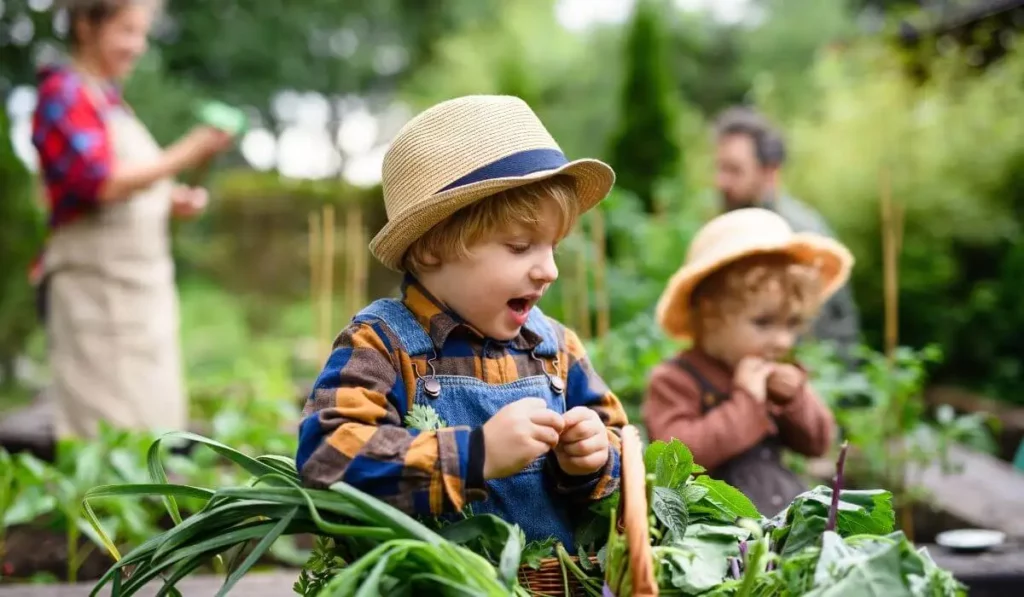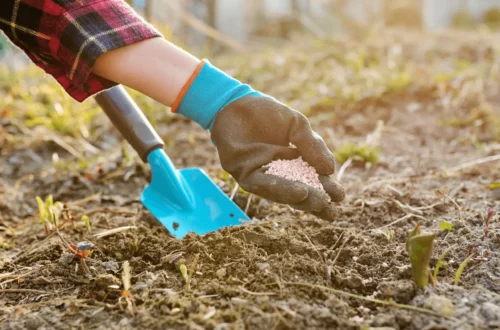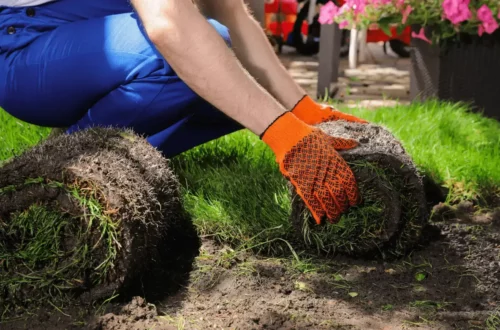A Comprehensive Guide to Organic Gardening for Newbies

Imagine walking through your own lush garden, filled with vibrant vegetables, fragrant herbs, and colorful flowers. Organic gardening offers a world of possibilities for newbies looking to connect with nature, grow their own food, and create an oasis of beauty right at home.
But where do you start? How can you ensure a successful organic garden without the use of harmful chemicals?
In this comprehensive guide to organic gardening for newbies, we’ll cover everything you need to know to get started. From selecting the right site and preparing the soil to choosing the best plants and implementing effective watering and feeding techniques, we’ll walk you through each step of the process.
Along the way, we’ll share expert tips and tricks, demystify common myths, and provide practical advice for maintaining a thriving organic garden while avoiding pests and diseases. Whether you’re a first-time gardener or looking to enhance your green thumb, this guide will equip you with the knowledge and confidence to grow your own delicious harvests and beautiful blooms.
Introduction to Organic Gardening for Beginners
Organic gardening is a sustainable and environmentally-friendly approach to growing plants, which focuses on working with nature rather than against it. For beginners, it offers a rewarding experience of growing fresh, healthy produce while minimizing the use of synthetic chemicals.
The benefits of organic gardening are numerous. By avoiding the use of chemical pesticides and fertilizers, organic gardens support biodiversity and promote a healthier ecosystem. Organic produce is also known to be richer in nutrients and can have enhanced flavors compared to conventionally grown counterparts.
To start your organic gardening journey, it is essential to understand the principles behind it. Organic gardening relies on natural methods of pest control, soil enrichment, and plant nutrition. By embracing these principles, you contribute to the long-term health and fertility of your garden.
In the upcoming sections, we will discuss various aspects of organic gardening to equip beginners with the knowledge and skills needed for success.
Select Your Site
Choosing the right site for your organic garden is crucial for its success. Here are some key factors to consider when selecting a site:
Sunlight
Ensure that your garden receives adequate sunlight throughout the day, preferably at least six hours. Most vegetables and herbs require full sun to thrive. Observe your prospective garden area and take note of any shady spots caused by surrounding trees or buildings.
Drainage
Good drainage is essential for healthy plant growth. Avoid areas that are prone to waterlogging or have poor drainage. Excess water can lead to root rot and other fungal diseases, compromising the health of your plants. If your chosen area has drainage issues, consider raised beds or container gardening.
Proximity to Water Source
Having a nearby water source is convenient for regular watering. Adequate and consistent watering is vital for the health of your organic plants. Consider the distance to the nearest water source and ensure it is easily accessible.
Soil Quality
Before starting your garden, test the soil quality. Organic gardening thrives in nutrient-rich, well-draining soil. Conduct a soil test to determine the pH level, nutrient content, and organic matter. If your soil is lacking in nutrients or has an unfavorable pH level, consider amending it with organic matter like compost or well-rotted manure.
Potential Obstacles
Take note of any existing obstacles that may hinder plant growth, such as large tree roots or structures that cast excessive shade. These obstacles can compete for nutrients or limit sunlight availability. It’s best to choose an area where plants can have ample space to grow without being overshadowed or restricted.
By carefully selecting the right site for your organic garden, you set a solid foundation for healthy plant growth and bountiful harvests. Remember to plan ahead and consider factors like sunlight, drainage, proximity to water source, soil quality, and potential obstacles. Following these guidelines will go a long way in ensuring the success of your organic gardening endeavors.
Use Great Soil
In organic gardening, one of the key factors that contribute to the success of your garden is the quality of the soil. Good soil provides essential nutrients to plants, promotes healthy root development, and enhances overall plant growth. Here are some tips for using great soil in your organic garden:
Soil Preparation
Before planting, it’s important to prepare your soil properly. Start by removing any weeds or grass from the area where you plan to establish your organic garden. Loosen the soil using a garden fork or tiller to improve its texture and drainage. Break up large clumps and remove any rocks or debris.
Composting
Compost is a valuable organic amendment for your soil. It enriches the soil with nutrients and improves its structure. Start a compost pile with kitchen scraps, yard waste, and other organic materials. Regularly turn the compost pile to speed up decomposition and ensure proper aeration. Once the compost is fully decomposed, incorporate it into your garden soil to enhance its fertility.
Organic Fertilizers
Organic fertilizers are made from natural sources and provide essential nutrients to your plants. They are slow-release and promote long-term soil health. Choose organic fertilizers that are specifically formulated for your plant’s needs, such as nitrogen-rich fertilizers for leafy greens or phosphorus-rich fertilizers for flowering plants. Apply organic fertilizers according to the package instructions, taking care not to overapply, as it can lead to nutrient imbalances or burns.
Mulching
Mulching is another effective technique to improve soil health in organic gardening. Apply a thick layer of organic mulch, such as straw or wood chips, around your plants. Mulch helps to retain soil moisture, suppress weed growth, and regulate soil temperature. It also breaks down over time, adding organic matter to the soil and promoting beneficial microbial activity.
By following these tips for using great soil in your organic garden, you can create an optimal growing environment for your plants. Remember, healthy soil equals healthy plants, so invest time and effort in soil preparation, composting, and using organic fertilizers. Your plants will thank you with robust growth and bountiful harvests.
Pick the Perfect Plants
When starting your organic garden, choosing the right plants and seeds is essential for success. Considerations such as climate, growing season, and pest resistance play a significant role in determining which plants are best suited for your garden. Here are some tips to help you pick the perfect organic plants:
Consider the Climate:
– Research the climate in your area to identify which plants thrive best.
– Choose plants that are well-suited to your specific climate zone.
– Look for varieties that are known to be more tolerant of extreme temperatures or challenging weather conditions.
Assess the Growing Season:
– Determine the length of your growing season to select plants that can reach maturity within that time frame.
– Opt for faster-growing varieties if you have a shorter growing season.
– Consider using season extenders, such as greenhouses or row covers, to prolong the growing season for certain plants.
Look for Pest Resistance:
– Find plants that have natural resistance to common garden pests in your area.
– Look for disease-resistant varieties to minimize the risk of plant infections.
– Consider companion planting, which involves growing certain plants together to repel pests or attract beneficial insects.
Remember, the key to successful organic gardening is choosing plants that are well-adapted to your specific environment and require minimal intervention. By selecting the perfect organic plants, you’ll set yourself up for a thriving and sustainable garden.
Water Wisely
Watering your organic plants properly is essential for their growth and health. By following best practices, you can ensure that your plants receive the right amount of moisture without wasting water. Here are some tips to help you water your organic garden wisely:
Drip Irrigation
Consider using a drip irrigation system to deliver water directly to the roots of your plants. This method minimizes water waste by avoiding evaporation and runoff. Drip irrigation also helps prevent diseases by keeping the foliage dry.
Targeted Watering
Focus your watering efforts on the root zone of each plant. This allows the water to reach the areas where it is needed the most. Avoid watering the leaves excessively as this can increase the risk of fungal diseases.
Avoid Overwatering
Overwatering can lead to root rot and other problems in your organic garden. Check the moisture level of the soil before watering by sticking your finger about an inch into the ground. If it feels dry at that depth, it’s time to water. Otherwise, wait a bit longer.
Remember, different plants have different water needs, so it’s important to observe and understand the requirements of each variety in your garden. By using drip irrigation, targeting your watering, and avoiding overwatering, you can help your plants thrive while conserving water.
Feed Your Plants
In organic gardening, feeding your plants with the right nutrients is essential for their growth and overall health. Fortunately, there are several organic feeding methods that you can use to ensure your plants receive the essential nutrients they need. Here are some effective strategies to consider:
Composting
Composting is a natural and sustainable way to enrich your soil and provide nutrients to your plants. Start by creating a compost pile using a mix of kitchen scraps, yard waste, and organic matter. Turn the pile regularly to promote decomposition and create nutrient-rich compost. Apply the mature compost to your garden beds or use it as a top dressing around your plants.
Organic Fertilizers
Organic fertilizers, such as bone meal, blood meal, and fish emulsion, are derived from natural sources and are rich in essential nutrients. These fertilizers can be applied directly to the soil or mixed with water and used as a foliar spray. Follow the instructions on the product packaging for proper application rates.
Natural Supplements
Certain natural supplements, such as seaweed extract and worm castings, provide additional micronutrients and beneficial microorganisms to your plants. These supplements can be used as a soil drench or foliar spray to boost plant health and stimulate growth.
Remember to always read and follow the instructions on the packaging when using any organic feeding methods. It’s important to strike a balance and not overfeed your plants, as excessive nutrients can lead to nutrient imbalances or burn the plants.
Maintain With Mulch
Mulching plays a crucial role in organic gardening by providing multiple benefits, including weed control, moisture retention, and regulation of soil temperature. Here are some key points to consider when incorporating mulch into your organic garden:
Weed Control
Mulching helps suppress weed growth, preventing invasive plants from competing with your desired crops. By creating a barrier between the soil surface and sunlight, mulch inhibits weed germination and growth. Use a thick layer of organic mulch, such as straw, leaves, or compost, to effectively smother weeds and reduce the need for manual weeding.
Moisture Retention
Mulch acts as a natural insulator, reducing evaporation and conserving moisture in the soil. This is especially important during hot and dry periods. A thick layer of mulch helps retain moisture, keeping the soil consistently moist and providing a reliable water source for your plants. Additionally, mulch protects against soil erosion caused by heavy rain or irrigation.
Soil Temperature Regulation
Mulch acts as a buffer between the soil and the external environment, moderating soil temperature fluctuations. In hot weather, mulch provides shade and keeps the soil cool, preventing heat stress on plant roots. Conversely, during colder months, mulch acts as an insulator, helping to retain heat and protect delicate roots from freezing temperatures.
Remember to replenish mulch as it decomposes over time. This will maintain the beneficial effects and ensure ongoing weed control, moisture retention, and soil temperature regulation in your organic garden. With proper mulching, you can create a thriving and sustainable garden ecosystem.
Keep in mind that organic gardening revolves around using natural and biodegradable materials, so opt for organic mulch options like straw, leaves, or compost. Avoid synthetic mulch or materials treated with chemicals, as they may not align with the principles of organic gardening.
Rotate Crops
One of the key practices in organic gardening is crop rotation. Crop rotation involves changing the location of crops each year to prevent nutrient depletion and reduce the risk of pests and diseases. By rotating the crops, you can maintain soil fertility, minimize the buildup of pests, and interrupt the lifecycle of disease-causing organisms.
Here are a few benefits of crop rotation in organic gardening:
Prevent Nutrient Depletion:
Different crops have varying nutrient requirements. By rotating crops, you can prevent the depletion of specific nutrients from the soil. Certain plants, such as legumes, have the ability to fix nitrogen in the soil, replenishing this essential nutrient for the following crops.
Break Pest and Disease Cycles:
Pests and diseases often have specific target crops. By rotating crops, you can disrupt their lifecycle and reduce their population. It also helps to break the buildup of pests and diseases, as they are less likely to overwinter and multiply in the same location.
Improve Soil Structure:
Crop rotation improves the soil structure by allowing different crops to interact with the soil in different ways. Deep-rooted plants can help break up compacted soil, while surface-rooted plants can help prevent erosion. This leads to healthier, more productive soil in the long run.
Planning Your Crop Rotation:
Start by dividing your plants into different groups based on their crop families. Avoid planting crops from the same family in the same location for multiple years. Rotate crops in a sequence that ensures each plant family has a different location each year.
By implementing a crop rotation plan, you can maintain the health and productivity of your organic garden while reducing the reliance on synthetic pesticides and fertilizers. Crop rotation is a sustainable practice that promotes long-term soil fertility and plant health.
Remember to always keep a record of your crop rotation plan to ensure a successful rotation year after year. With proper planning and implementation, your organic garden will thrive and provide bountiful harvests for years to come.
Clean Up Debris
Maintaining a clean and clutter-free organic garden is crucial for its overall health and pest control. Regular clean-up and removal of plant debris should be a top priority for every gardener. Here are some reasons why it’s important to keep your garden free from debris:
1. Pest Prevention: Fallen leaves, dead plants, and decaying fruits can attract pests and insects, which can quickly multiply and infest your garden. By removing debris promptly, you minimize the risk of pest problems.
2. Disease Control: Plant debris can harbor fungal infections, bacteria, and other pathogens that may spread to healthy plants. Cleaning up debris reduces the risk of diseases taking hold and spreading throughout your garden.
3. Weed Management: Organic gardens can still be vulnerable to weed growth. By clearing away debris, you remove potential hiding spots and eliminate weed seeds that may have accumulated.
Remember to compost or dispose of the debris appropriately. A clean and tidy garden not only promotes better plant growth but also ensures a healthier and more enjoyable gardening experience. So, make it a habit to regularly clean up your organic garden to maintain its vitality and discourage unwanted pests and diseases.
Also read: A Complete Guide to Year-Round Vegetable Gardening: 10 Steps for Success
Enjoy Your Harvest!
Congratulations, newbie organic gardeners! After all the hard work and care you’ve put into your garden, it’s time to reap the rewards of your labor. Harvesting organic produce is an exciting and fulfilling experience that allows you to enjoy the freshness and flavor of homegrown food. Here are some tips to make the most of your organic harvest:
1. Timing is key:
– Harvest your crops at the peak of ripeness for the best flavor and nutritional value.
– Different plants have different harvesting times, so refer to seed packets or gardening resources for guidance.
2. Handle with care:
– Gently pick and handle your produce to avoid bruising or damage.
– Use pruners or scissors for fruits and vegetables with stems to prevent unnecessary stress on the plant.
3. Keep it clean:
– Wash your harvested produce with water to remove any dirt or debris.
– Avoid using harsh soaps or detergents, as they may leave residues.
4. Store properly:
– Some fruits and vegetables are best stored in the refrigerator, while others prefer a cool, dry place.
– Check the specific storage requirements for each crop to maintain their freshness and prolong their shelf life.
5. Share the bounty:
– If your harvest is more than you can consume, consider sharing it with friends, family, or local food banks.
– Sharing the joy of freshly harvested organic produce is a great way to spread the benefits of your garden.
Also read: How to Grow a Sustainable Garden: A Beginner’s Guide
Remember, the taste and satisfaction of homegrown organic food are unmatched. So savor each bite and relish the fact that you’ve played a part in bringing nutritious, flavorful, and sustainable food to your table. Happy harvesting!





